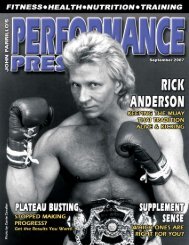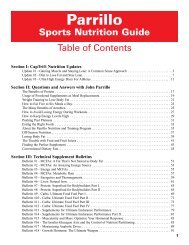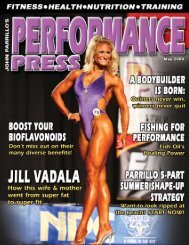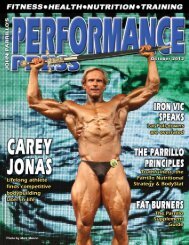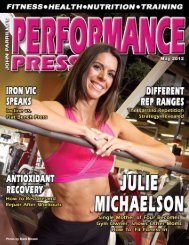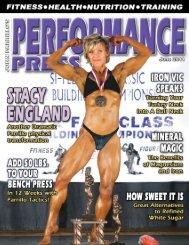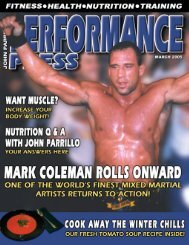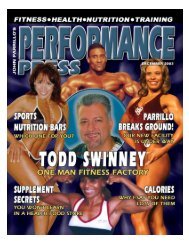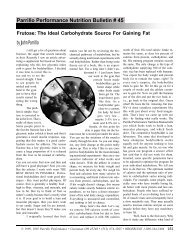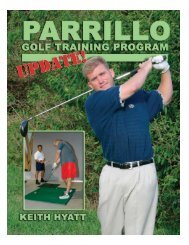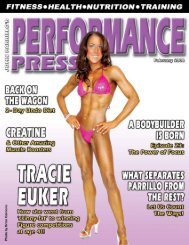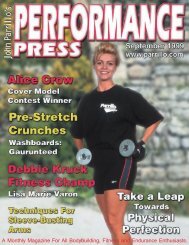John Parrillo'sJohn Parrillo's - Parrillo Performance
John Parrillo'sJohn Parrillo's - Parrillo Performance
John Parrillo'sJohn Parrillo's - Parrillo Performance
Create successful ePaper yourself
Turn your PDF publications into a flip-book with our unique Google optimized e-Paper software.
Side Splits: How to Make Them a Part of Your Posing Routine<br />
Lean as much of your bodyweight as you<br />
can reasonably handle onto your outstretched<br />
legs. At the same time inhale<br />
and tighten up your entire body, especially<br />
your hamstrings and groin muscles.<br />
Flex your glutes and abs as well. Pinch<br />
the floor with your heels, as if you are<br />
trying to slide upward. If you succeed<br />
and actually start to ascend, load the<br />
hams even more. The only way to go is<br />
down! It is important to build up this<br />
muscle tension gradually, over a period<br />
of a couple of seconds, to minimize the<br />
possibility of an injury. Peak the tension<br />
at about eighty-percent of your maximum<br />
and keep it there.<br />
•Start breathing – but in a very shallow<br />
fashion. This way you can maintain tightness<br />
in your abs. At this point your butt<br />
is against the wall and your hands are<br />
barely touching the step stool. Your arms<br />
are ready to catch you if you goof up,<br />
but they are not carrying any weight -<br />
unless your hams are very weak. Your<br />
heels dig hard into the floor as your hamstrings<br />
and adductors keep flexing.<br />
•Maintain steady tension in your legs,<br />
glutes, and abs. This is crucial. If you<br />
semi-relax your leg muscles, you are wasting<br />
your time. You need to be able to put<br />
up with the progressive fatigue and pain<br />
of an extended isometric contraction to<br />
make the wall split work.<br />
•Hold this tension until<br />
your hamstrings and hip<br />
adductors literally collapse<br />
from exhaustion. It<br />
may take a few seconds<br />
or it may take a few minutes<br />
– but it will eventually<br />
happen. It will not be<br />
enjoyable, but that is irrelevant.<br />
•When you feel your<br />
tired quivering muscles<br />
involuntarily relaxing, use<br />
your contrast breathing<br />
and let out a sigh of relief.<br />
Contrast breathing will<br />
help your beat-up hamstrings<br />
and inner thighs<br />
go limp. This is precisely<br />
what we want: first we<br />
tense the target muscles<br />
until they spaz-out, then<br />
we sink into the stretch<br />
blocked using contrast breathing.<br />
The degree of stretch will<br />
increase as your exhausted<br />
body slips down<br />
the wall.<br />
•Make a point to only<br />
allow your feet to slide<br />
out to the sides, rather<br />
than slide forward. Otherwise, you defeat<br />
the purpose of the stretch. To maximize<br />
safety, only go down an inch or so<br />
before catching yourself with your hands<br />
(remember the stool?). Adjust your<br />
weight using your arms and the stool. If<br />
this explanation is too complex, buy my<br />
videotape Beyond Stretching. On second<br />
thought, buy my videotape anyway,<br />
even if everything is perfectly clear! Back<br />
to work:<br />
•With hands still on the stool, shift your<br />
weight back to your heels, flex your hams<br />
into exhausted submission once again.<br />
Keep plugging away until you are sitting<br />
down on the floor with your shoulder<br />
blades touching the wall and your<br />
legs spread wide. Then lift yourself up<br />
with your arms, spread your legs even<br />
Sit on the floor<br />
with your back to<br />
the wall and<br />
spread your legs.<br />
Slide newspapers<br />
under your feet if<br />
you exercise on<br />
carpet. On the<br />
photo I use folded<br />
towles on a hardwood<br />
floor.<br />
Set a chair or a<br />
step stool in front<br />
of you for additional<br />
safty. I don’t<br />
in the photo because<br />
it would<br />
have<br />
your view of the<br />
stretch. A ballet<br />
bar above you<br />
works even better.<br />
wider, and start all over.<br />
•Repeat the drill until you get tired or<br />
your range of motion stops improving,<br />
whichever comes first. Once you have<br />
hit your limit for the day, pack your gym<br />
bag. Rest for two to five days before<br />
you split again, preferably right after<br />
your next leg workout.<br />
When you can do a full, toes-up side<br />
split against the wall, ditch the wall. The<br />
only technique change you should make<br />
for free splits (no wall) is that you move<br />
your hands off the stool and behind your<br />
back as you make the landing approach.<br />
Without the pressure of the wall, you<br />
have to push your hips forward with your<br />
arms.<br />
There are at least three reasons to make<br />
the wall split a regular part of your training.<br />
First, this procedure improves flexibility<br />
and helps improve your odds<br />
against blowing out your knees during a<br />
squat – particularly if you allow them to<br />
bow in. The ballet hip turnout, delivered<br />
by the wall-split, will make the task<br />
of tracking your knees over your toes a<br />
lot easier. Second, the wall-split drill will<br />
allow you to widen your squat and sumo<br />
deadlift stance without grinding your<br />
hips and knees to pulp. A super wide<br />
squat and Sumo stance can potentially<br />
boost a powerlifter’s total and expand<br />
their assistance exercise arsenal. Bodybuilders<br />
and fitness athletes who take<br />
up mutant wide-stance squats as a result<br />
of their newly found flexibility will<br />
be excited at the new muscle development<br />
and striations that suddenly appear<br />
in the most unlikely places.<br />
Lastly, full splits done onstage during<br />
a posing routine is extremely dramatic<br />
and can translate into a competitive advantage.<br />
Nothing in bodybuilding is<br />
quite so impressive as seeing a heavily<br />
muscled athlete effortlessly slide down<br />
into a full-split to conclude a killer posing<br />
routine. I have my own selfish reason:<br />
if we can get bodybuilders to incorporate<br />
these flexibility movements into<br />
their posing routines, spectators will start<br />
treating bodybuilding contests like athletic<br />
events. Flexible bodybuilders performing<br />
athletic posing routines will<br />
quickly dispel the notion that bodybuilding<br />
is nothing more then a human version<br />
of a cattle and livestock auction.<br />
Until next month Comrades.<br />
Info-Line: 513•531•1311 <strong>John</strong> <strong>Parrillo</strong>’s <strong>Performance</strong> Press • May 1999 13



